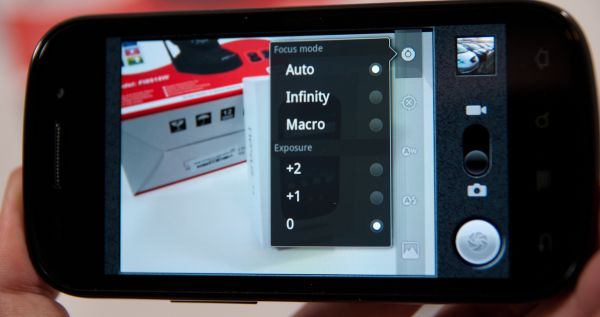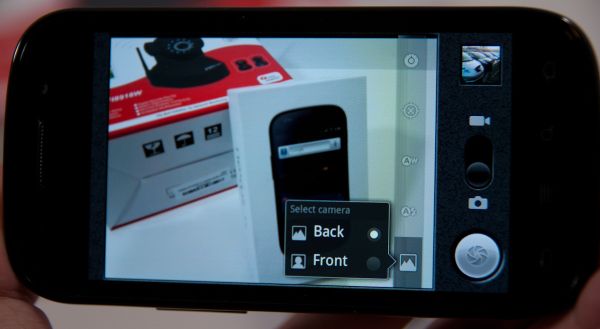Nexus S and Android 2.3 Review: Gingerbread for the Holidays
by Brian Klug on December 14, 2010 4:08 PM EST- Posted in
- Smartphones
- Samsung
- Nexus S
- Gingerbread
- Android 2.3
- Mobile
Camera Analysis
If there’s anything to be learned in a straight comparison between the Nexus One and Nexus S, it’s again that megapixels don’t matter. I never was a huge fan of the Nexus One camera - there’s a strange undersaturation in some images, and that extra glare from having another layer of plastic between the lens and your object where grime could collect.
The Nexus S is overall much improved, but still not perfect. Again, the obvious analogue here is to the Galaxy S, but side by side quality on the Fascinate looks markedly superior in our lights-on test. With the lights off and the flash set to auto, the Nexus S is much improved. The reason is that the stock camera now correctly illuminates the object while running the autofocus routine - the result is that in the dark shots are now focused properly. Further, you get an idea for whether the flash reaches far enough to actually do any good. Kudos to Google for fixing this.
Even more Kudos, however, for adding some manual focus settings. Tap on the settings button, and you can select from Auto, Infinity, and Macro. Objects beyond hyperfocal distance are essentially in focus when the camera is focused to infinity, so if you’re shooting photos beyond a certain distance and don’t want to bother with wasting time focusing, infinity is super useful. Likewise, macro gets you the closest possible focus.
The back facing camera isn’t the best we’ve seen, but it’s an improvement from the Nexus One. In our lightbox test, there’s still a lot of missing dynamic range and detail in the texture on the Exacta camera, but there’s so much more contrast compared to the Nexus One.
I took photos in our bench location, in the light box with lights on and off, and then just casually while I carried it around.
There’s also a button along the row of other camera settings buttons for changing to the front facing camera. When you’re in the front facing camera, a few options go away. You can’t change resolution, and focus controls are also obviously gone since the camera is fixed focus. Resolution is VGA. Quality on the front facing camera isn’t spectacular, but then again the aperture diameter on that camera is barely 1 mm. The front facing camera also flips-images horizontally after capture.
What’s odd about the Nexus S is that video encoding is only 720x480, not the HD 720P we’re used to seeing with the Galaxy S. Video is encoded in H.264 with AAC audio, at an average bitrate of 3,664 kilobits/s on the back camera. The front camera records at 640x480 with the same codecs at just over 1 megabit/s.
I noticed that audio doesn’t quite sync up in the front facing camera video, which is a bit unnerving to say the least. The back camera is fine, and seems relatively smooth. Not having 720P is a disappointment, hopefully someone unlocks HD recording on the Nexus S same as was done on the Nexus One. It certainly isn’t a matter of the SoC not being powerful enough if Galaxy S can do it.
I took a video with the front and back facing camera at our usual location:
Rear Camera:
Front Camera:
And one more video in a different location per some commenters asking for an indoor to outdoor progression for gauging quality.





































73 Comments
View All Comments
ltcommanderdata - Tuesday, December 14, 2010 - link
I asked this in the previous LG Optimus 7 review and didn't get an answer. I was wondering if your benchmarks for the iPhone and iPad have been updated to use iOS 4.2.1? iOS 4.2.1 introduces Safari 5 compared to Safari 4 in the previous iOS 4.1 so I was interested in seeing what performance benefits there are.Brian Klug - Tuesday, December 14, 2010 - link
Oh interesting, I haven't updated them but will do so soon. I don't know if they'll go into this review, but definitely in the myTouch 4G and LG Optimus One pieces that are coming shortly. Thanks for pointing that out.-Brian
Brian Klug - Tuesday, December 14, 2010 - link
There we go, I've updated the web synthetics graphs (Brmark and Sunspider 0.9) with numbers from iOS 4.2.1. Looks like Brmark saw a nice jump, but Sunspider did virtually nothing.-Brian
DigitalFreak - Tuesday, December 14, 2010 - link
I'd be all over a Nexus if they made one with CDMA and either WiMax or LTE.ltcommanderdata - Tuesday, December 14, 2010 - link
Thanks for the quick response.Just a question on the charts. They mention the older iOS version as 4.2 while the newer one is iOS 4.2.1. Were the older results actually iOS 4.2 since I don't believe that was publicly released. They went directly from iOS 4.1 to iOS 4.2.1.
Brian Klug - Tuesday, December 14, 2010 - link
Oops you're right. I got confused thinking - hmm, what's last the version of iOS I was running - since I played around with the beta for a while. Fixed now ;)-Brian
evan919 - Tuesday, December 14, 2010 - link
Awesome, thanks!sprockkets - Tuesday, December 14, 2010 - link
He took the video with an iphone. Kinda ironic ;)samven786 - Tuesday, December 14, 2010 - link
I was wondering did your nexus s had any random shutdowns? This is known issue on the captivate and the vibrant.Brian Klug - Tuesday, December 14, 2010 - link
Thus far no, it's been speedy consistently. I've been using it (somewhat brutally) nonstop since mid-Friday. I haven't seen it grind to a halt yet.-Brian